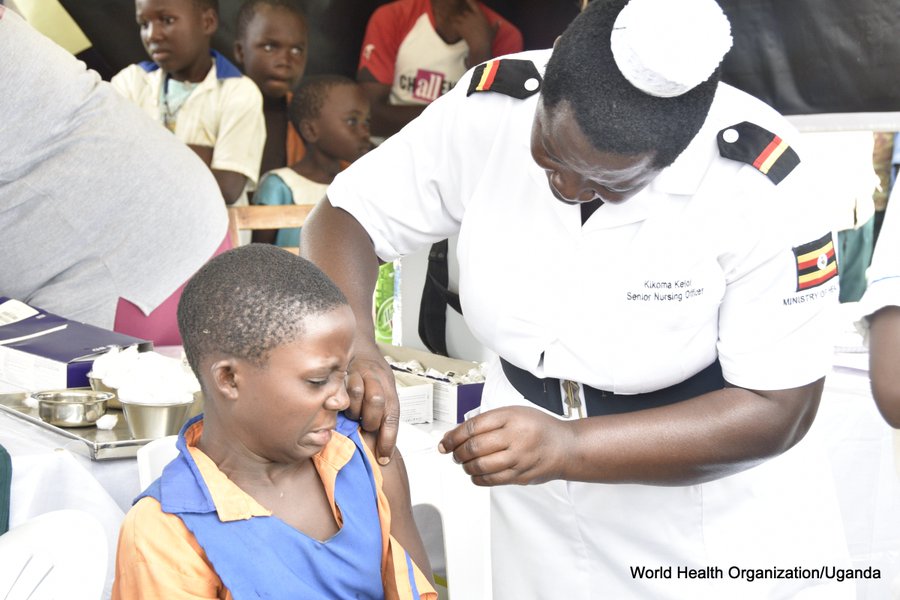
Photo by WHO Uganda Office
Researchers in Uganda are concerned about high-risk human papillomavirus (hrHPV) infections in HIV-positive women, emphasizing that early screening during standard HIV care can reduce cervical cancer rates.
Their new study, published in BMC Cancer in February 2024, titled: Prevalence of genital high-risk human papillomavirus infections and associated factors among women living with HIV in Uganda, highlights the need for integrated cervical cancer screening in HIV care programs.
In the groundbreaking study, Harriet Nakigozi, Rawlance Ndejjo, William Bazeyo, Annet Nabaggala, Caroline Achola, Moses Iga, Simeon Kalyesubula, Ben Kanamwangi, Gerald Mutungi, Charles Batte, David Mukunya, Lawrence Sserwanga, Godfrey Gemageine, Charles Akiya Oyoo, and Susan Nabadda, investigated the genital prevalence of hrHPV infection and associated factors in Ugandan HIV-positive women.
The researchers examined 5,856 HIV-positive women aged 25–49 attending antiretroviral therapy (ART) clinics in 15 public health facilities, including 12 regional referral hospitals in Mubende, Naguru, Masaka, Mbarara, Kabale, Soroti, Mbale, Hoima, Fort Portal, Gulu, Lira and three general hospitals: Lacor, TASO Jinja, Kyenjojo.
Selected based on a high volume of patients on antiretroviral therapy (an HIV treatment), a functional laboratory, and mother-to-baby care services, the study found that 34.3 per cent of the 5856 HIV-positive women being attended to were infected with HPV, a family of over 200 viruses that cause cervical cancer.
Human papillomavirus infection causes cervical cancer, which is preventable. The disease is the fourth most frequent cancer in women globally, with approximately 660,000 cases and 350,000 deaths in 2022 recorded. According to the World Health Organization (WHO), women living with HIV are six times more likely to develop cervical cancer.
In Uganda, HIV prevalence remains high. According to the 2020 Uganda Population-based HIV Impact Assessment, 5.8 per cent of adults aged 15 or older live with the disease, with higher rates among women (7.2 per cent) than men (4.3 per cent). This means that about 1.3 million adults in Uganda are living with HIV. Uganda at 28.8 cases per 100,000 people per year, also has the seventh highest cervical cancer rates globally and second in East Africa after Tanzania.
The common preventions for cervical cancer include getting the HPV vaccine, regular screening for early detection, practising safe sex, and avoiding smoking. However, developing countries like Uganda face a challenge in terms of access to screening, diagnosis, and treatment, resulting in late presentation and additional demands on the already stretched health system.
Consequently, the researchers, in their new study, write: “The lack of a comprehensive cervical cancer prevention program, diagnosis or screening for HPV oncogenic genotypes or high-risk genotypes has resulted in a high burden and increasing cases of cervical cancer in Uganda. In Uganda, 34.3 per cent of HIV-positive women aged 25–49 attending ART at public health institutions had high-risk HPV infections."
The study found the prevalence of specific HPV genotypes at alarming rates. HPV 16, the known precursor to cervical cancer, was detected in 15.8 per cent of the cases, HPV 18/45, another high-risk type, was present in 15.4 per cent of infections, while additionally, the other high-risk human papillomavirus genotypes accounted for 68.8 per cent of the cases, a sobering revelation pitting women living with HIV, whose body defence systems are already weakened, at high risk.
The study identified several key factors contributing to the high prevalence of hrHPV among HIV-positive women. These included high parity (having multiple children), engaging in early sexual activity, and having multiple sexual partners. Notably, education level and smoking status also emerged as significant influencers, with higher education levels associated with increased HPV prevalence and smoking linked to specific hrHPV genotypes.
HIV impacts immune function in ways that can increase susceptibility to persistent HPV infection. Specifically, HIV leads to reduced CD4 + and CD8+, T-cell numbers and function, along with higher regulatory T-cell levels. This dampened, anti-inflammatory state makes it harder to clear HPV infection. Given the high HPV prevalence and immune dysfunction, women with HIV are at substantially increased risk for not only HPV acquisition but also progression to invasive cervical cancer compared to HIV-negative women. Active and persistent HPV infections are more likely during uncontrolled HIV disease, the researchers explain.
In 2015, WHO had recommended that testing for high-risk HPV infection be incorporated into cervical cancer screening programs using molecular nucleic acid tests but, according to the current study, this has not been effected in Uganda. The coverage for human papillomavirus screening also remains low at less than 10 per cent for women aged 25–49 years.
“Other research has also found that women living with HIV have a higher incidence and faster progression of cervical precancerous lesions compared to HIV-negative women. Persistent infection with high-risk HPV types, especially HPV16 and 18, is a major risk factor for developing cervical cancer. The increased vulnerability to persistent infection in HIV-positive women further escalates their risk of cervical cancer.” The study reads in part.
HPV infection is a well-established cause of cervical cancer, the researchers argue that to address this challenge among the high-risk populations, screening be incorporated into HIV care programs in order to increase early detection and save lives, noting that using self-collected vaginal samples for HPV testing, as observed in the study, is a feasible approach to improve screening access and coverage in resource-limited settings like Uganda.
“This strategy holds promise for enhancing cervical cancer prevention efforts among women living with HIV. Integrating cervical cancer screening into routine HIV care could help address the elevated burden of cervical cancer morbidity and mortality in this high-risk population. Routine HPV screening provides an opportunity to identify women with HPV and facilitate follow-up care as needed.” The study report reads.
The study's strengths lie in its use of highly specific HPV molecular assays (DNA or RNA) and its large sample size. As the first major study in Uganda to assess HPV prevalence in this population, it provides critical insights. Understanding these risk factors is essential for designing targeted interventions that can effectively reduce HPV-related complications and cervical cancer risks, particularly among HIV-positive women.
Please find the scientific paper here.
By Okeya John and Davidson Ndyabahika

